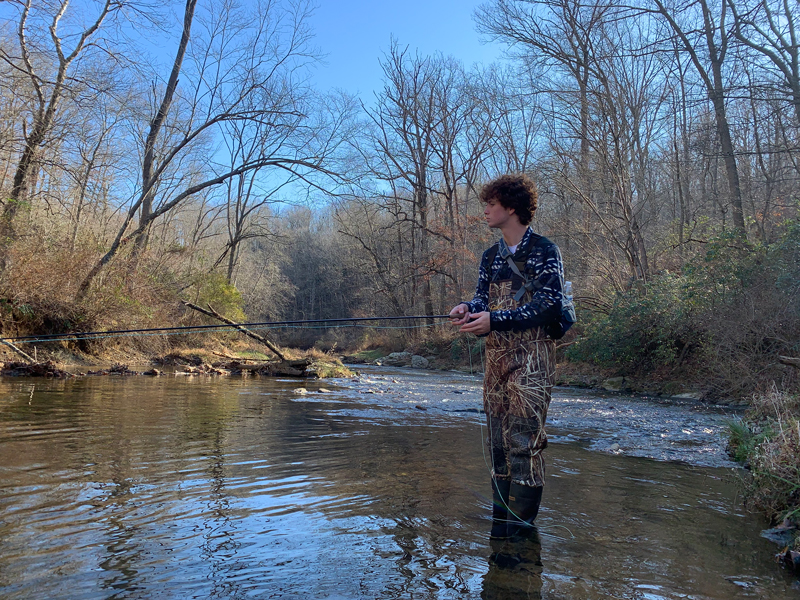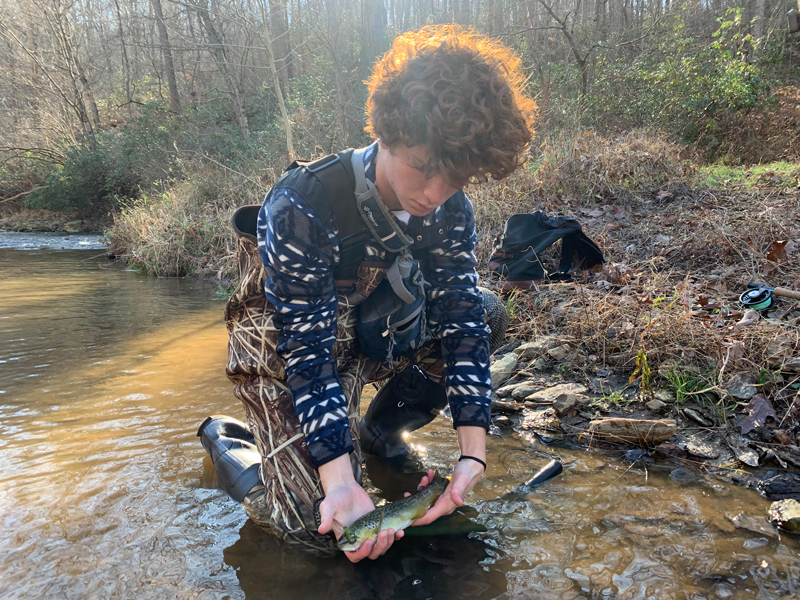Over the past summer I became a religious Loch Raven fisherman, though my skills on a spinner reel never yielded me much. On the reservoir’s banks I found myself distracted, often watching in awe as my younger brother Skeet reeled in fish after fish on our father’s 30-year-old Shakespeare fly rod.

In 2021, he shook the graphite dinosaur out of our garage fishing rod bundle and started practicing his cast in our backyard pond. By August of this year, I realized I wanted to follow in his footsteps. I asked Skeet for some lessons and finally began to understand fly fishing's cryptic lore. Once I started to get the hang of it, I ordered a cheap MaxCatch rod and slapped on dad's old Shakespeare reel. I’m still a mid-tier beginner at best, but already, I’ve gathered some fly-fishing wisdom that I wish I’d known before starting. Here are the greatest lessons I’ve learned:
- Fly Fishing is much more than the rod. If you are fishing what looks like a great spot and nothing is hitting, consider first how you entered the space. When I started, I focused so hard on learning the cast that I forgot about my overall presence. This sport demands that you tread lightly and be more conscious of spooking the fish. Skeet told me that your shadow is an important thing to watch, since fish naturally fear the looming shade of an approaching predator. I find that sunfish or river chub (fallfish to some) won’t hesitate to bite even if you're talking, wearing bright clothes, or stomping through the stream. But when the target species is trout, your behavior has to be much more deliberate.
- Don’t be cocky, watch your cast. “With yee fly, thou may taketh fish from thy stream, but be wary, thou tree shalt take thee fly from thy rod,” Book of Hook, 23:19. If you are just starting to fly fish, it’s best to find some water with few to no trees around you. While you first learn to cast, the fake fly on your line might act about as independent of your intentions as a real one. The tree is a great foe to even the most experienced fly-fisher, so for someone new it’s no contest. It’s not just trees either — I’ve lost flies to lily pads, submerged sticks, and even smacked many a fly right off the leader on the unforgiving docks of Lake Artemisia. I recommend you avoid trees outright until you have some sense of where you're putting your fly.
- Start on the little fish. Don’t get me wrong, it's exciting to reel in a hefty slob, but unless you go overkill with a six- or seven-weight rod (which wouldn’t be very sportsmanlike) the rod’s tip will be pretty delicate. The tip of a fly rod is a sensitive thing that doesn’t like to be pushed. Don’t let its flexibility fool you, that sucker will snap when bent in the wrong way. I recommend practicing on little fish before leveling up to more mighty opponents. This way you can learn how to carefully reel in without much risk. Little fish are also easier to catch, and those mini successes are going to keep you encouraged.
- Don’t rush the reel. Similar to the point above, the great lesson here is don’t break anything. Unlike a spinning rod, reeling in requires more patience and grace, so tire ‘em out before you bring ‘em in. Suppose you catch something a little bigger than expected, and instead of tiring it out you simply drag it in as fast as possible. Once the fish gets close and sees the approaching net, it's going to take off again. If you’re lifting your rod skyward at the same instant, you better hope the tippet breaks before the tip. The moment you get fish-fever and start yanking with all your might, you’re going to snap the line and leave a fish with a hook in its mouth. Or worse, the tip will snap and you may feel the sensation of a hook tugging your wallet.
- Listen, listen, listen to the veteran fisherman. Sometimes it’s better to experiment with fly fishing on your own without someone breathing down your neck and critiquing your every move. However, for your first few times, take a friend who can give you the basics before you develop bad habits. They can be hard to break once set in stone. Also, take some time to visit local fly fishing shops and talk to the pros. When I asked a fly-shop clerk about wet flies and nymphing on a recent trip to a local store, I learned more in 10 minutes than my brother could give me in four months. These people love to impart their knowledge unto us lowly beginners, so go oblige them. Then maybe buy a fly. One hand washes the other, and all that.
- When it comes to casting, doing less is more. You can watch hundreds of YouTube videos on how to cast. I’m probably not the best source on the issue. However, one thing that many of these virtual teachers forget to mention is that when you toss a cast, it requires very little physical effort. As you start, you may find yourself using your whole arm to demand the fly goes to a certain spot, but it won’t work. Instead of casting with your whole arm from the shoulder, try to focus on the forearm and wrist. Feel the tension through the rod and remain mindful of your technique. You will come to understand how the fly wants to be thrown, not how you want to throw it. Casting a fly requires timing and grace, not brute strength or sheer will.
- Think about where you’re going to land the fish. Around October, I took my fly rod to Patuxent Research Refuge. The lake there is bordered almost everywhere with lily pads, so the best spot I found to cast a streamer was on a dock that stood a few feet out into the water. After about an hour, I finally snagged what had to be a largemouth. I fought it for a minute and started reaching for my net. Then I realized there were three feet of lily pads between me and the fish. The fish dove under my feet, tangled in the lily pads, and snapped the tippet. I lost a streamer and left a fish with a hook in its lip. Consider where you're going to net and follow through before you hook a fish. You can’t lift it straight out of the water as on a spinning rod.
- Learn one fly at a time (and one before another). Although it’s tempting to jump between dry fly, wet fly, nymphs, and streamers, you're going to blow a gasket if you try to learn all at once. Focus on one type of fly at a time. I’d recommend starting on a dry fly. Even if real flies aren’t falling, you still have a good chance of catching a sunfish. They don’t seem to care about the hatch. I recommend starting light and working your way up to sinking flies.
- Try to work upstream. This mostly matters if you're fishing a muddy-bottom river, which I’m used to around north-central Maryland. If you start wading from upstream and walk down you're going to cloud the water below you, and if the fish aren’t spooked, then they're blinded from your bait. Casting upstream (usually at a little bit of an angle) also helps for mimicking the natural drift of fly or nymph. A big part of fly fishing that isn’t so obvious when you start, is “drag.” Imagine you’re casting downstream. The line will lose all slack very quickly. If it’s a dry fly, it will stop flowing and send ripples through the water. That’s drag. A real fly is too light to make ripples, and fish know it. Once they see the fly disturb the water, the fish will get wise to your tricks and refuse to attack this unnatural foreign object.
- Remember, it’s supposed to be fun. Fly fishing is many things: it’s fun, it’s relaxing, and it’s art. But it ain’t easy. Impatient and short-tempered folk might feel the urge to give up, but don’t! Let me tell you this now, your first few attempts will be frustrating. It will demand your effort and attention. Becoming a fly angler is not something you go do, it’s something you become over a long time, and the learning never ends. Make sure you’re in the mood to learn and know there will be mistakes along the way. When you feel the headache of perplexity pressing on your brow, put down the rod. Take in the quiet scenery. Watch the water for fish. Learn how to check the hatch. Basically do anything else to put your mind at ease. After you take some deep breaths, try again.
And again, and again, and again…

- By Hunter Hine